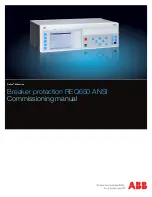
Two step overvoltage protection OV2PTOV
M13798-3 v14
Overvoltages may occur in the power system during abnormal
conditions such as sudden power loss, tap changer
regulating failures, and open line ends on long lines.
Two step overvoltage protection (OV2PTOV) function can be
used to detect open line ends, normally then combined with a
directional reactive over-power function to supervise the
system voltage. When triggered, the function will cause an
alarm, switch in reactors, or switch out capacitor banks.
OV2PTOV has two voltage steps, each of them with inverse
or definite time delayed.
OV2PTOV has a high reset ratio to allow settings close to
system service voltage.
Two step residual overvoltage protection ROV2PTOV
M13808-3 v10
Residual voltages may occur in the power system during
earth faults.
Two step residual overvoltage protection ROV2PTOV function
calculates the residual voltage from the three-phase voltage
input transformers or measures it from a single voltage input
transformer fed from an open delta or neutral point voltage
transformer.
ROV2PTOV has two voltage steps, each with inverse or
definite time delay.
Reset delay ensures operation for intermittent earth faults.
6. Secondary system supervision
Fuse failure supervision FUFSPVC
SEMOD113820-4 v11
The aim of the fuse failure supervision function FUFSPVC is to
block voltage measuring functions at failures in the secondary
circuits between the voltage transformer and the IED in order
to avoid inadvertent operations that otherwise might occur.
The fuse failure supervision function basically has three
different detection methods, negative sequence and zero
sequence based detection and an additional delta voltage
and delta current detection.
The negative sequence detection algorithm is recommended
for IEDs used in isolated or high-impedance earthed
networks. It is based on the negative-sequence quantities.
The zero sequence detection is recommended for IEDs used
in directly or low impedance earthed networks. It is based on
the zero sequence measuring quantities.
The selection of different operation modes is possible by a
setting parameter in order to take into account the particular
earthing of the network.
A criterion based on delta current and delta voltage
measurements can be added to the fuse failure supervision
function in order to detect a three phase fuse failure, which in
practice is more associated with voltage transformer
switching during station operations.
7. Control
Switch controller SCSWI
M13486-3 v7
The Switch controller (SCSWI) initializes and supervises all
functions to properly select and operate switching primary
apparatuses. The Switch controller may handle and operate
on one three-phase device or up to three one-phase devices.
Circuit breaker SXCBR
M13489-3 v6
The purpose of Circuit breaker (SXCBR) is to provide the
actual status of positions and to perform the control
operations, that is, pass all the commands to primary
apparatuses in the form of circuit breakers via binary output
boards and to supervise the switching operation and position.
Bay control QCBAY
M13447-3 v7
The Bay control QCBAY function is used together with Local
remote and local remote control functions to handle the
selection of the operator place per bay. QCBAY also provides
blocking functions that can be distributed to different
apparatuses within the bay.
Local remote LOCREM/Local remote control LOCREMCTRL
M17086-3 v8
The signals from the local HMI or from an external local/
remote switch are connected via the function blocks
LOCREM and LOCREMCTRL to the Bay control QCBAY
function block. The parameter
ControlMode
in function block
LOCREM is set to choose if the switch signals are coming
from the local HMI or from an external hardware switch
connected via binary inputs.
Logic rotating switch for function selection and LHMI
presentation SLGAPC
SEMOD114908-4 v9
The logic rotating switch for function selection and LHMI
presentation SLGAPC (or the selector switch function block)
is used to get an enhanced selector switch functionality
compared to the one provided by a hardware selector switch.
Hardware selector switches are used extensively by utilities,
in order to have different functions operating on pre-set
values. Hardware switches are however sources for
maintenance issues, lower system reliability and an extended
purchase portfolio. The selector switch function eliminates all
these problems.
Selector mini switch VSGAPC
SEMOD158756-5 v8
The Selector mini switch VSGAPC function block is a
multipurpose function used for a variety of applications, as a
general purpose switch.
VSGAPC can be controlled from the menu, from a symbol on
the single line diagram (SLD) on the local HMI or from Binary
inputs
1MRK 505 362-BEN B
Busbar protection REB650 2.1 IEC
Product version: 2.1
14
ABB






































